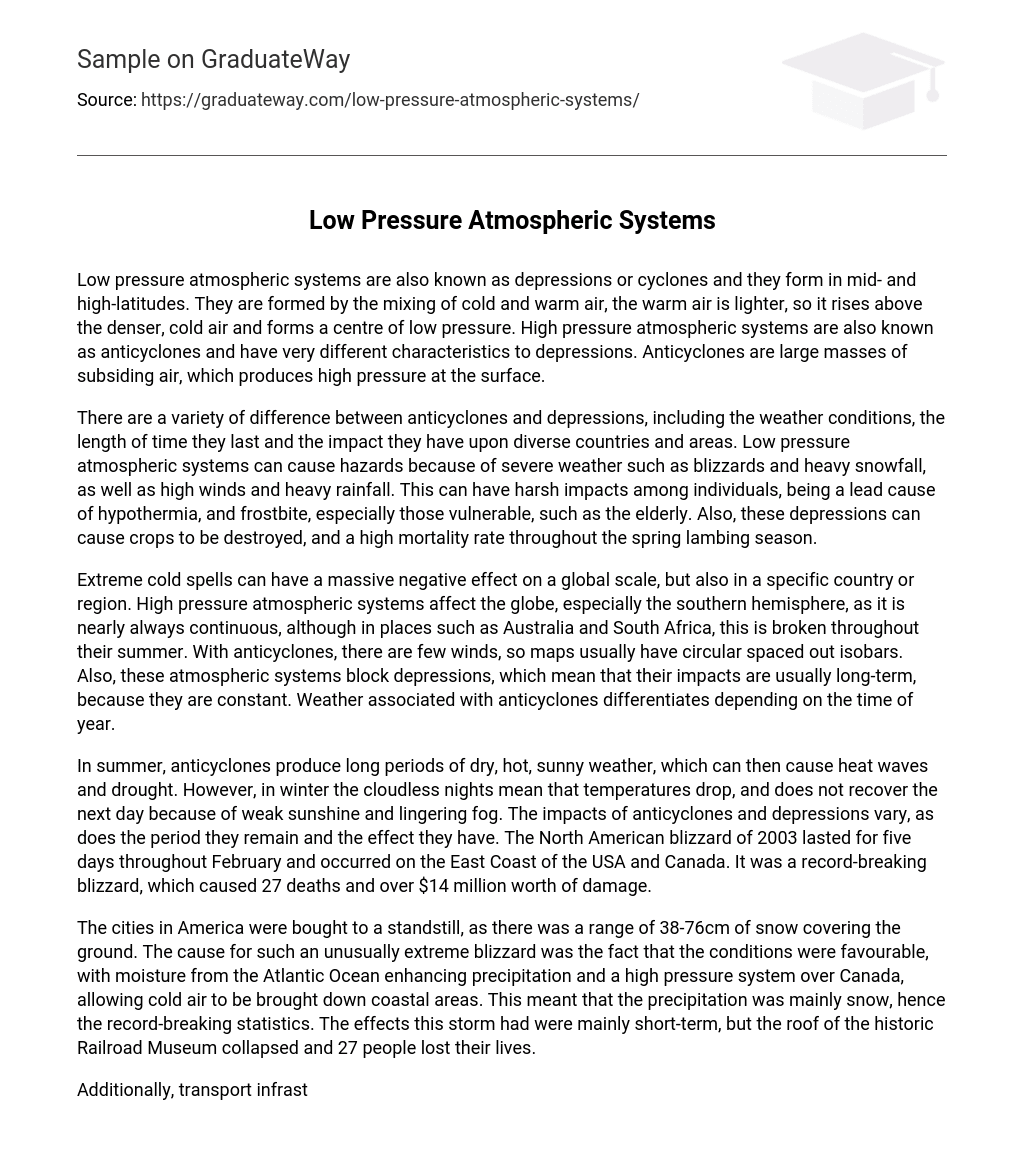Low pressure atmospheric systems, also known as depressions or cyclones, form in mid- and high-latitudes by the convergence of cold and warm air. The lighter warm air rises above the denser cold air, creating a center of low pressure. Conversely, high pressure atmospheric systems called anticyclones have distinct features from depressions. Anticyclones consist of large masses of descending air that produce high surface pressure.
Anticyclones and depressions have opposite qualities in terms of weather conditions, duration, and their influence on different regions. Depressions, characterized by low atmospheric pressure, can lead to dangerous situations such as blizzards, heavy snowfall, strong winds, and intense rainfall. These extreme weather events can have serious consequences for individuals, especially the elderly who are more vulnerable to hypothermia and frostbite. Additionally, depressions can damage crops and negatively impact mortality rates during the spring lambing season.
Extreme cold spells have a significant impact on both global and regional scales. Notably, the southern hemisphere experiences the effects of high pressure atmospheric systems during their summer season, with some variations noticed in Australia and South Africa. These systems produce minimal wind patterns and create maps displaying scattered circular isobars. As a result, the formation of depressions is impeded, leading to prolonged and consistent consequences. The weather conditions linked to anticyclones vary depending on the time of year.
Anticyclones during summer bring about prolonged periods of dry, hot, and sunny weather. This ultimately results in heat waves and drought. Conversely, in winter, the absence of clouds overnight causes temperatures to drop and not rise the next day because of weak sunshine and persistent fog. The impacts of anticyclones and depressions vary in terms of duration and effects. One notable instance is the North American blizzard of 2003 which lasted for five days in February. It affected the East Coast of the USA and Canada, leading to 27 deaths and causing over $14 million worth of damages.
Weather conditions in America caused cities to come to a halt. A massive amount of snow, ranging from 38 to 76cm, covered the ground, resulting in an extremely severe blizzard. The unique combination of factors contributed to this extraordinary event. Moisture from the Atlantic Ocean amplified precipitation, while a high-pressure system over Canada brought cold air to the coastal areas. Consequently, the precipitation predominantly manifested as snow, leading to record-breaking snowfall measurements. Although the impacts of this storm were mostly temporary, there were tragic consequences. The roof of the historic Railroad Museum collapsed, and sadly, 27 lives were lost.
Transport infrastructure was halted and three major airports were closed, resulting in mainly short-term impacts. Depressions can cause horrendous destruction, while anticyclones typically lead to long-term impacts like the 2003 drought in Britain and Europe. The drought affected various locations, with a particular focus on the UK, France, and Portugal. Although not all impacts are negative, the heat wave did boost the tourist industry in most countries and increased sales for summer items such as barbeques and sun cream. However, this positive outlook is short-lived.
In the UK, air pollution led to more than 200 deaths, surpassing the average by 10%. The excessive heat caused roads to melt and created transportation challenges. Temperatures inside the London Underground reached 37°, which exceeded the permissible limit for transporting animals. Additionally, people who took time off work to enjoy the hot weather incurred a daily expense between £7.5 million and £10 million in the UK. On the other hand, France encountered up to 30,000 fatalities and experienced a decrease of harvests by 30% to 50% compared to data from 2002.
Moreover, because of insufficient water availability for cooling purposes, the nuclear power plants were incapable of meeting the growing energy demands, especially for air conditioning and refrigeration. In response to the most severe forest fires in thirty years, Portugal declared a State of Emergency, resulting in approximately 35,000 hectares of forests, farmland, and scrubland being devastated and causing 1300 fatalities. Additionally, individuals deliberately ignited fires with the intention of receiving compensation, leading to 80 families being forced out of their residences. The consequences of anticyclones endured in all these countries for more than a month and brought about historically high temperatures not witnessed in five centuries.
The effects of anticyclones on various scales, including regions, countries, and globally, are highlighted. The consequences of low-pressure systems and high-pressure systems vary depending on the geographic location. This can range from less developed areas to technologically advanced ones that may suffer damage or destruction. In general, more developed countries experience fewer casualties than less developed ones, regardless of whether it is a depression or a cyclone. Moreover, research indicates that depressions typically have a shorter duration of impact on an area compared to anticyclones; however, this is not always true.
Extended periods of flooding or heavy snowfall can cause significant damage and lasting effects following a depression. Although low pressure atmospheric systems generally have more immediate impacts on a particular region compared to high pressure systems, both types of hazards can lead to long-term problems due to secondary consequences. Moreover, the location plays a crucial role in determining the extent and severity of these hazards, with Less Economically Developed Countries (LEDCs) being especially susceptible and prone to enduring consequences.





